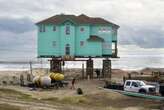A Mongolian farm wanted to improve its branding and help its community, while developing new products. A dual brand strategy did the trick: one brand for its overarching smart farm initiative, and another, Smart Berry, for its flagship strawberry produce to be launched early next year. This approach nurtured a new community around sustainable agriculture, provided work opportunities for local farmers, encouraged healthier consumer lifestyles, and contributed to the nation’s economic development.
Many communities like the Mongolian farm seek to unlock their potential by developing new products or hosting community gatherings. Communities, in this context, are gatherings of people with shared interests, visions, and a sense of kinship. While these initiatives are undeniably necessary, they often have a short-term focus that’s not conducive to long-term sustainable community development.
Through my 15 years as CEO of The bread and butter, a global brand consulting firm, I’ve determined four ways in which branding can future-proof a community and generate a lasting impact by bolstering its economic growth and human network.
1. Use branding to empower communities
For a community to survive and continue to provide meaningful offerings to its members, it must be able to generate revenue, which most communities do by offering products for sale. Although these products are frequently innovative and high quality, they tend to lack brand power, restricting their reach, sales, and brand awareness to solely those in the immediate vicinity of the community.
A robust brand, however, can massively expand a community’s brand awareness and, consequently, revenue. Earlier this year, for example, The bread and butter collaborated with the indigenous Yanesha community in Peru to establish a brand for its coffee farming collective. This new brand, Tierra Fuerte, which received an honorable mention for a 2024 World Changing Ideas Award by Fast Company, has allowed the collective to not only enter the domestic Peruvian market, but also strategically position itself to enter the global market.
Good brands have a symbiotic relationship with their communities. The Tierra Fuerte brand does not dilute the unique strengths of its community, but rather allows the community to capitalize on them. By showcasing the Yanesha people’s low-impact, biodiverse approach to coffee farming, the brand massively expanded the product’s reach, generating more sales that are then redistributed back into the community.
2. Revitalize communities through storytelling
Older communities have woven rich narratives over the course of decades or centuries, which are integral to the lifeblood of a community. Storytelling branding can expand their reach and impact to rejuvenate the community, drive economic growth, and ensure they’re remembered by future generations.
The bread and butter’s work with Guri Traditional Market in Seoul, Korea, epitomizes this approach. We drew upon this market’s rich, 50-year history to position it as a “market of stories,” allowing consumers to not only access stories from previous generations, but also become part of a new chapter in the brand’s story. Our supergraphics for the brand reinforced this, tracing lines that mapped the customer journey onto the market’s quaint alleyways.
When using storytelling branding to futureproof a brand, it’s essential to have this dual focus: Consumers should feel part of a brand’s future, not just witness to its past. Just as the community continues to grow and evolve, so too should its brand story map out its journey from the past, into the future.
3. Use branding to develop new communities
Branding doesn’t just strengthen existing communities, but can also generate new communities by stimulating economic growth. As mentioned previously, the Mongolian government has been working with The bread and butter to establish and brand a series of smart farms, which circumnavigate the nation’s poor soil conditions to develop a new domestic farming industry that will reduce the prices of fresh produce.
A new community has developed around this new industry, bringing together both the traditional and cutting-edge agriculture techniques of local farmers and global smart-farming experts. Our branding allows this community to unify its potentially disparate perspectives, uniting it around a shared love for farming and healthy living.
In developing a brand that crystalizes this core focus on consuming locally produced fruit and vegetables like baby-leaf salads and strawberries, the Mongolian government expects its nation’s life expectancy to increase, as citizens pursue healthier lifestyles. This demonstrates the real-world positive impact that branding can have on community development.
4. Foster kinship on social media through branding
Community isn’t just rooted in the real world; social media platforms allow individuals to bond over shared interests and experiences. In these settings, brands often feel they must move quickly to adopt trending content to boost engagement by “going viral.” Building branding around kinship, however, can forge longer-lasting digital connections essential to a brand’s longevity.
The B Corp community, of which The bread and butter is a member, is a great example of a unique online presence oriented around a core ethos of “business as a force for good,” using the Certified B Corporation mark in online branding. To see this mark spread so widely across the internet and adopted by such a diverse array of brands demonstrates its potency. It represents a community of brands that discerning consumers can trust to act ethically.
This is the hallmark of good online branding: A flexible yet indelible sense of identity that can endure, even as fast-moving social media trends come and go.
Sooyoung Cho is CEO of The bread and butter brand consulting LLC.





No comments